Research Project on Preventing Abuse of Patients in Palliative Care
VerifiedAdded on 2023/01/09
|34
|8154
|31
Project
AI Summary
This research project, submitted as part of a HND in Health and Social Care Management at St Patricks College, investigates the critical issue of patient abuse within palliative care settings. The study aims to raise awareness of abuse, identifying factors predictive of palliative care needs and symptom load, and exploring decision-making processes regarding palliative care transitions. The research employs a literature review and questionnaires to gather data from healthcare practitioners, focusing on their roles in preventing abuse. The project examines the circumstances of abuse, the role of communication, and the factors contributing to abuse, with the ultimate goal of informing strategies for preventing elder abuse in palliative care and ensuring high-quality end-of-life care. The project includes an abstract, introduction, literature review, methodology, findings, discussion, and recommendations, along with appendices containing a questionnaire, consent form, and approval letter.
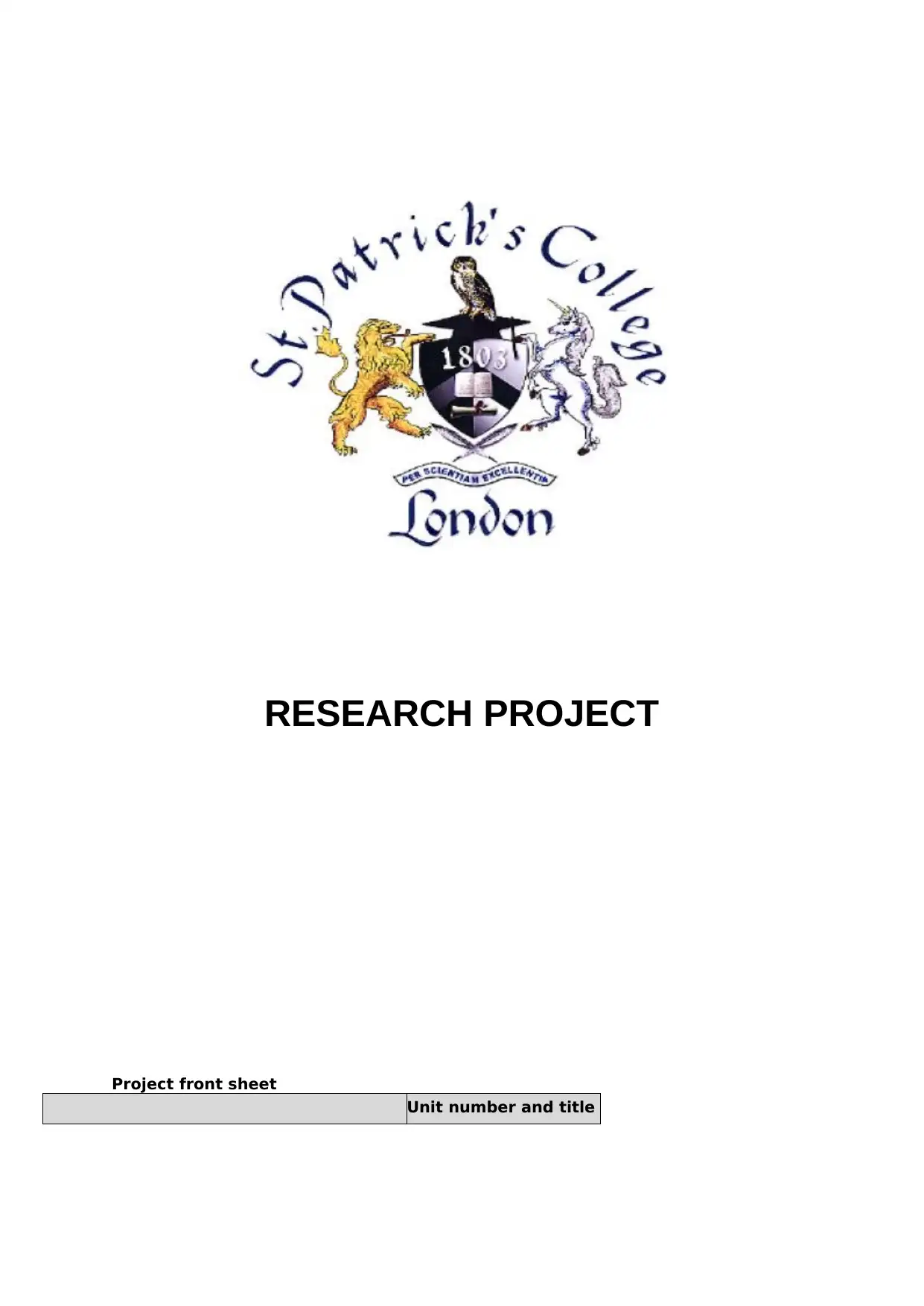
RESEARCH PROJECT
Project front sheet
Unit number and title
Project front sheet
Unit number and title
Paraphrase This Document
Need a fresh take? Get an instant paraphrase of this document with our AI Paraphraser
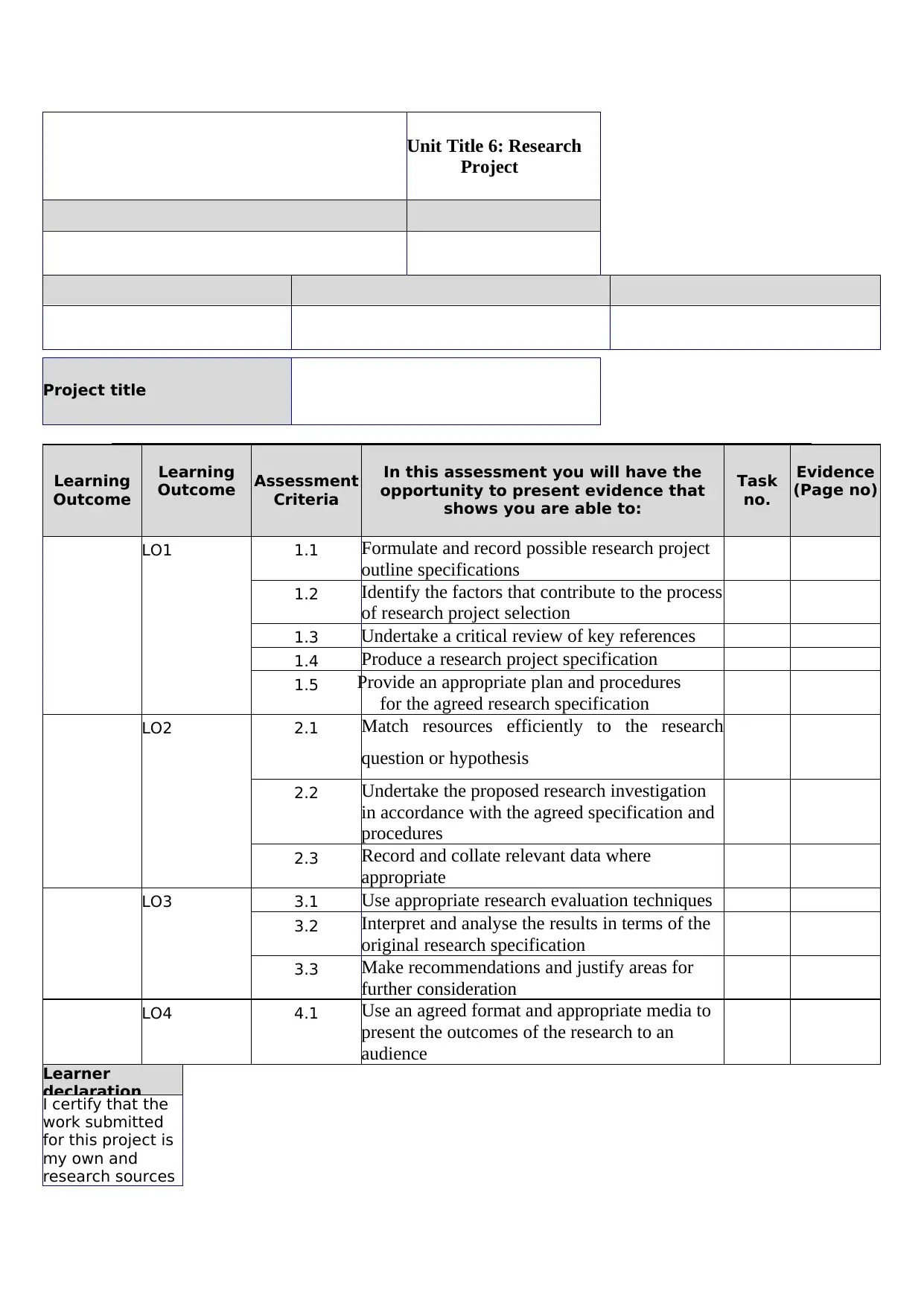
Unit Title 6: Research
Project
Project title
Learning
Outcome
Learning
Outcome Assessment
Criteria
In this assessment you will have the
opportunity to present evidence that
shows you are able to:
Task
no.
Evidence
(Page no)
LO1 1.1 Formulate and record possible research project
outline specifications
1.2 Identify the factors that contribute to the process
of research project selection
1.3 Undertake a critical review of key references
1.4 Produce a research project specification
1.5 Provide an appropriate plan and procedures
for the agreed research specification
LO2 2.1 Match resources efficiently to the research
question or hypothesis
2.2 Undertake the proposed research investigation
in accordance with the agreed specification and
procedures
2.3 Record and collate relevant data where
appropriate
LO3 3.1 Use appropriate research evaluation techniques
3.2 Interpret and analyse the results in terms of the
original research specification
3.3 Make recommendations and justify areas for
further consideration
LO4 4.1 Use an agreed format and appropriate media to
present the outcomes of the research to an
audience
Learner
declaration
I certify that the
work submitted
for this project is
my own and
research sources
Project
Project title
Learning
Outcome
Learning
Outcome Assessment
Criteria
In this assessment you will have the
opportunity to present evidence that
shows you are able to:
Task
no.
Evidence
(Page no)
LO1 1.1 Formulate and record possible research project
outline specifications
1.2 Identify the factors that contribute to the process
of research project selection
1.3 Undertake a critical review of key references
1.4 Produce a research project specification
1.5 Provide an appropriate plan and procedures
for the agreed research specification
LO2 2.1 Match resources efficiently to the research
question or hypothesis
2.2 Undertake the proposed research investigation
in accordance with the agreed specification and
procedures
2.3 Record and collate relevant data where
appropriate
LO3 3.1 Use appropriate research evaluation techniques
3.2 Interpret and analyse the results in terms of the
original research specification
3.3 Make recommendations and justify areas for
further consideration
LO4 4.1 Use an agreed format and appropriate media to
present the outcomes of the research to an
audience
Learner
declaration
I certify that the
work submitted
for this project is
my own and
research sources
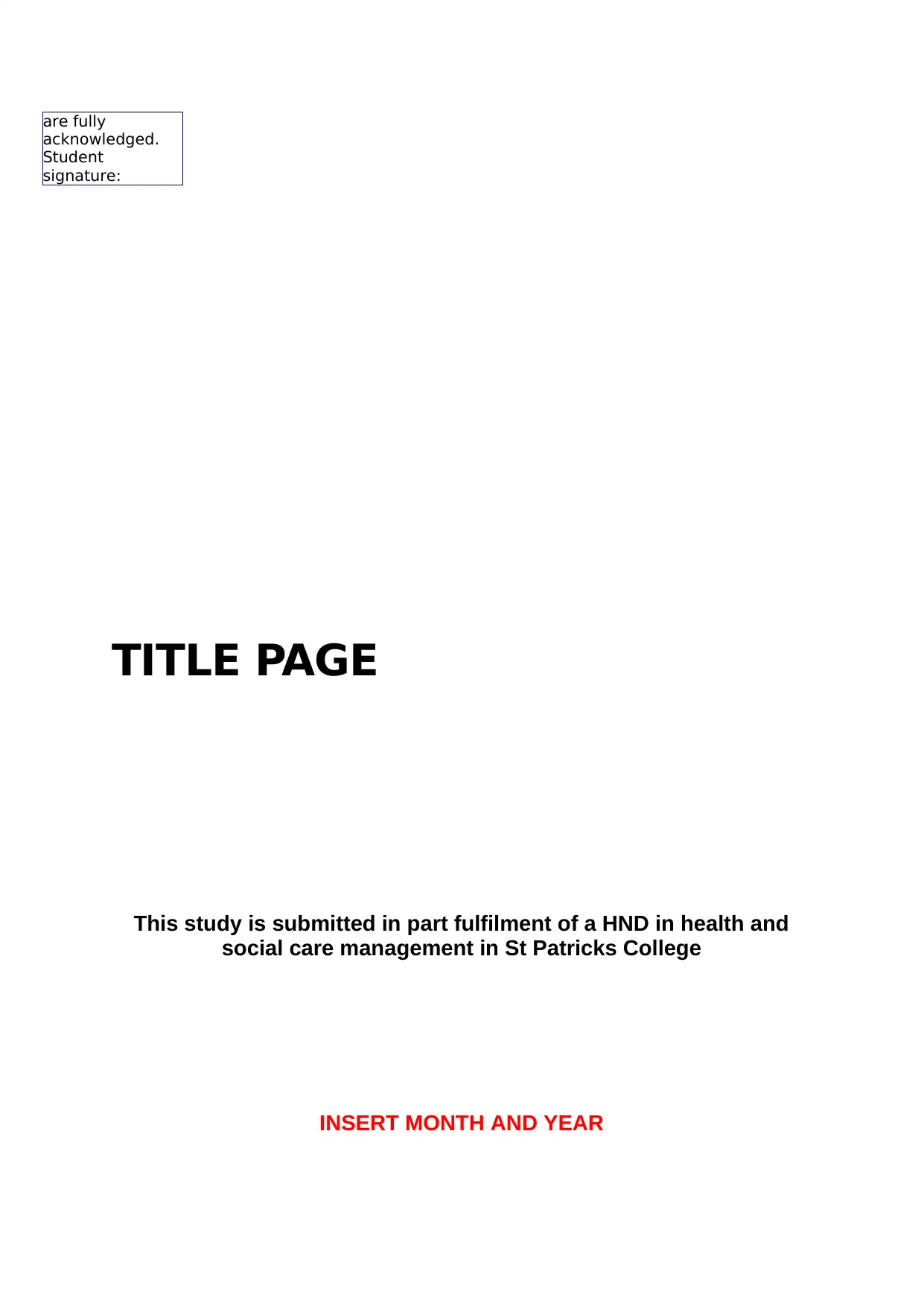
are fully
acknowledged.
Student
signature:
TITLE PAGE
This study is submitted in part fulfilment of a HND in health and
social care management in St Patricks College
INSERT MONTH AND YEAR
acknowledged.
Student
signature:
TITLE PAGE
This study is submitted in part fulfilment of a HND in health and
social care management in St Patricks College
INSERT MONTH AND YEAR
⊘ This is a preview!⊘
Do you want full access?
Subscribe today to unlock all pages.

Trusted by 1+ million students worldwide

Paraphrase This Document
Need a fresh take? Get an instant paraphrase of this document with our AI Paraphraser
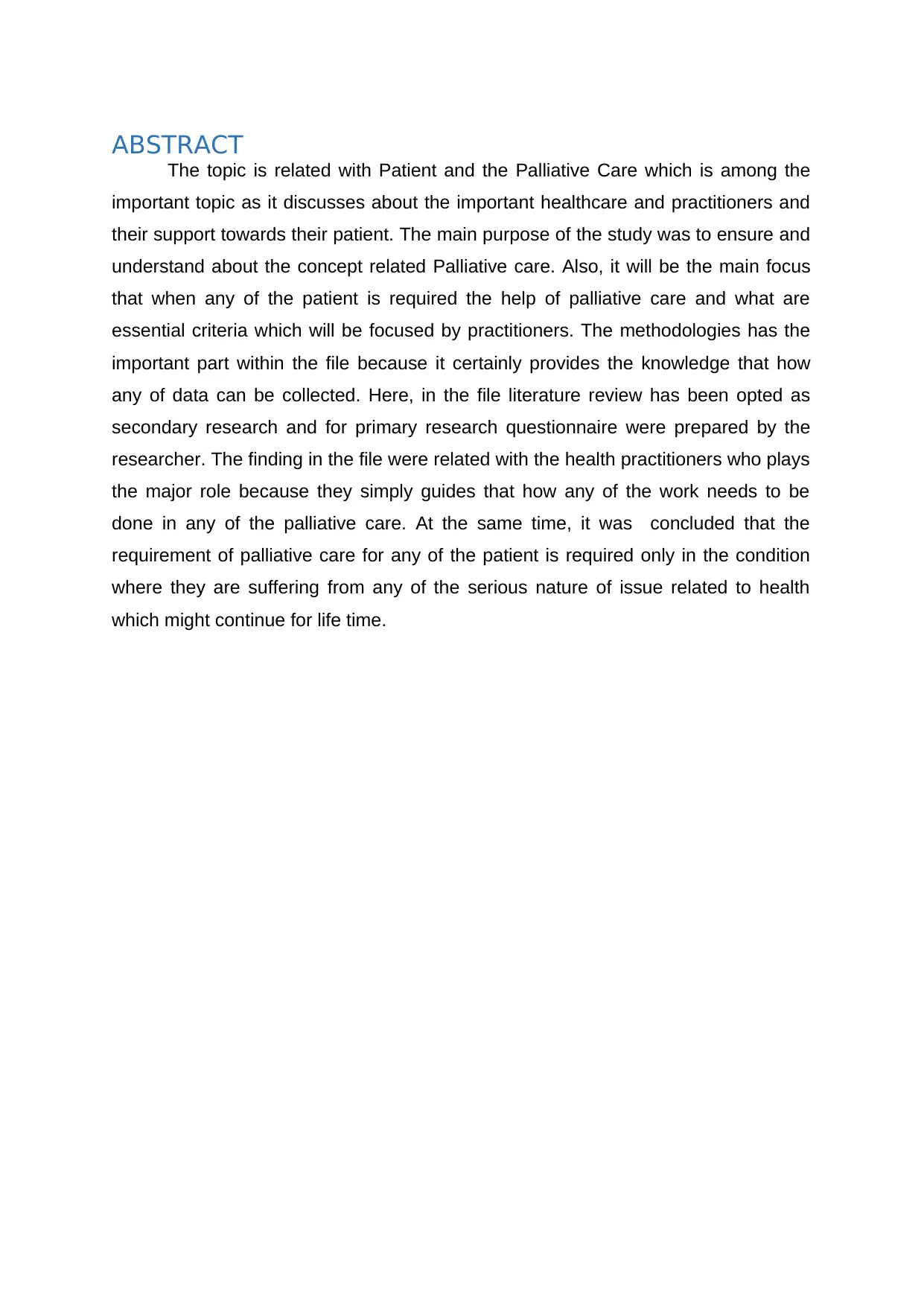
ABSTRACT
The topic is related with Patient and the Palliative Care which is among the
important topic as it discusses about the important healthcare and practitioners and
their support towards their patient. The main purpose of the study was to ensure and
understand about the concept related Palliative care. Also, it will be the main focus
that when any of the patient is required the help of palliative care and what are
essential criteria which will be focused by practitioners. The methodologies has the
important part within the file because it certainly provides the knowledge that how
any of data can be collected. Here, in the file literature review has been opted as
secondary research and for primary research questionnaire were prepared by the
researcher. The finding in the file were related with the health practitioners who plays
the major role because they simply guides that how any of the work needs to be
done in any of the palliative care. At the same time, it was concluded that the
requirement of palliative care for any of the patient is required only in the condition
where they are suffering from any of the serious nature of issue related to health
which might continue for life time.
The topic is related with Patient and the Palliative Care which is among the
important topic as it discusses about the important healthcare and practitioners and
their support towards their patient. The main purpose of the study was to ensure and
understand about the concept related Palliative care. Also, it will be the main focus
that when any of the patient is required the help of palliative care and what are
essential criteria which will be focused by practitioners. The methodologies has the
important part within the file because it certainly provides the knowledge that how
any of data can be collected. Here, in the file literature review has been opted as
secondary research and for primary research questionnaire were prepared by the
researcher. The finding in the file were related with the health practitioners who plays
the major role because they simply guides that how any of the work needs to be
done in any of the palliative care. At the same time, it was concluded that the
requirement of palliative care for any of the patient is required only in the condition
where they are suffering from any of the serious nature of issue related to health
which might continue for life time.
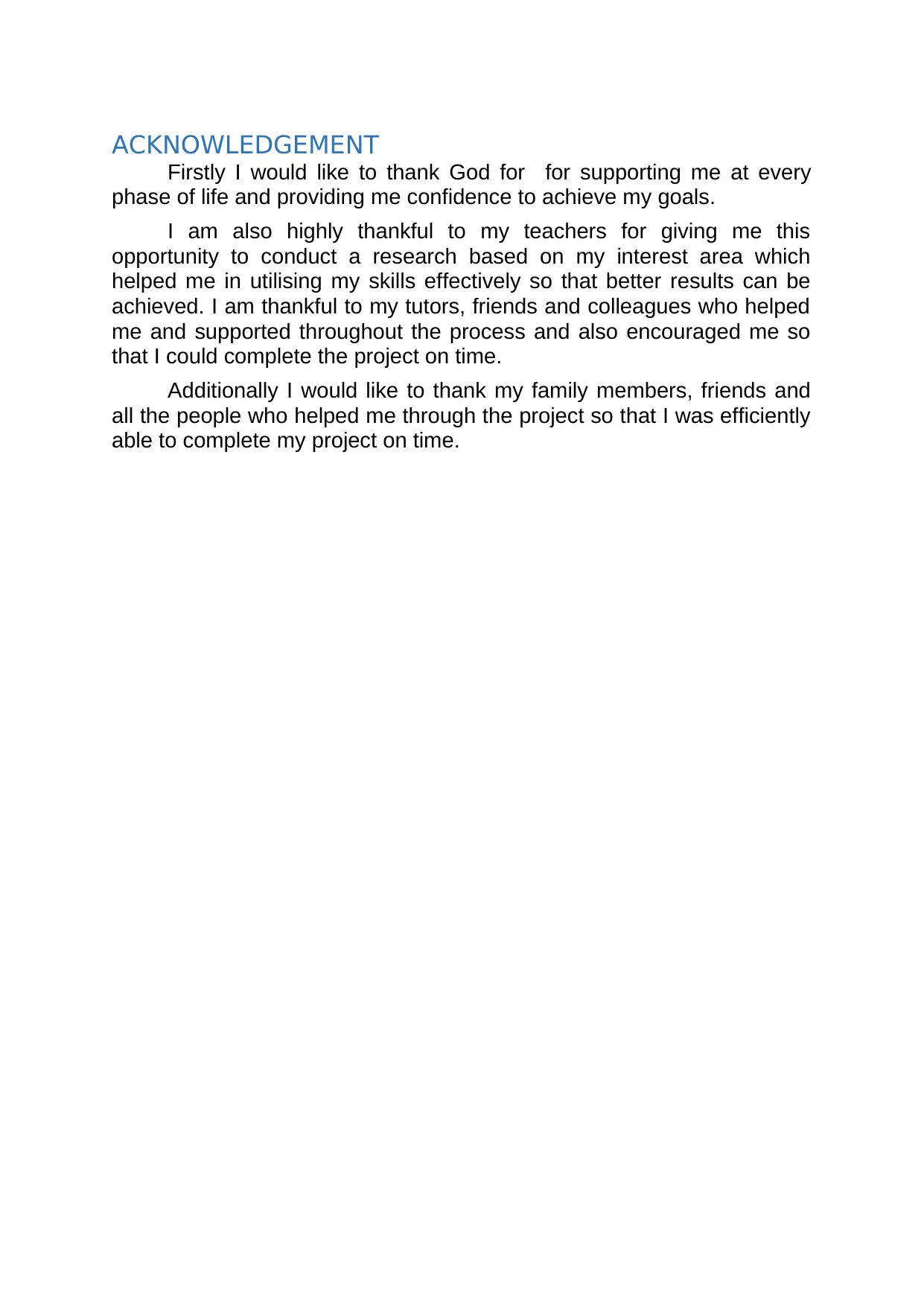
ACKNOWLEDGEMENT
Firstly I would like to thank God for for supporting me at every
phase of life and providing me confidence to achieve my goals.
I am also highly thankful to my teachers for giving me this
opportunity to conduct a research based on my interest area which
helped me in utilising my skills effectively so that better results can be
achieved. I am thankful to my tutors, friends and colleagues who helped
me and supported throughout the process and also encouraged me so
that I could complete the project on time.
Additionally I would like to thank my family members, friends and
all the people who helped me through the project so that I was efficiently
able to complete my project on time.
Firstly I would like to thank God for for supporting me at every
phase of life and providing me confidence to achieve my goals.
I am also highly thankful to my teachers for giving me this
opportunity to conduct a research based on my interest area which
helped me in utilising my skills effectively so that better results can be
achieved. I am thankful to my tutors, friends and colleagues who helped
me and supported throughout the process and also encouraged me so
that I could complete the project on time.
Additionally I would like to thank my family members, friends and
all the people who helped me through the project so that I was efficiently
able to complete my project on time.
⊘ This is a preview!⊘
Do you want full access?
Subscribe today to unlock all pages.

Trusted by 1+ million students worldwide
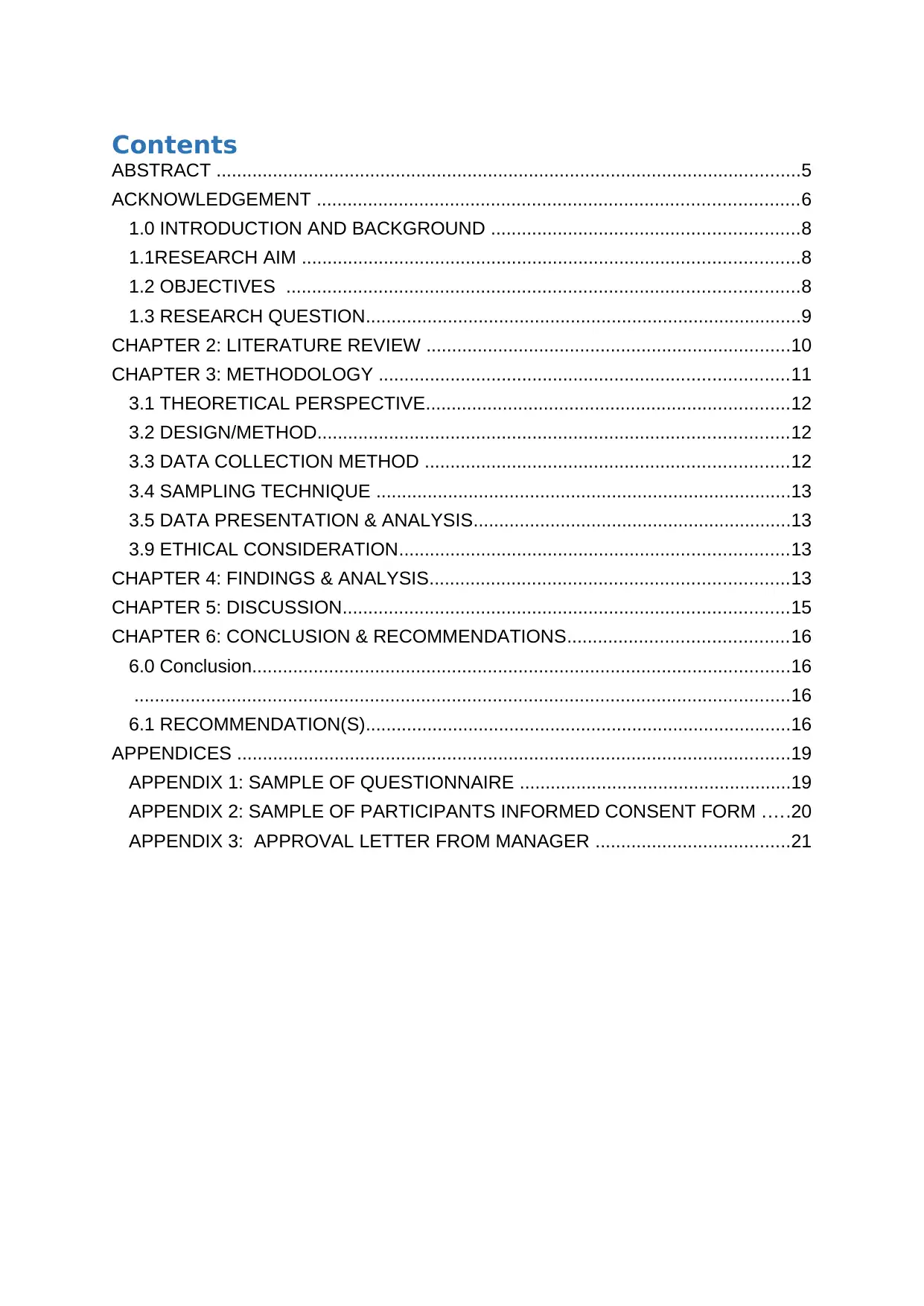
Contents
ABSTRACT ..................................................................................................................5
ACKNOWLEDGEMENT ..............................................................................................6
1.0 INTRODUCTION AND BACKGROUND ............................................................8
1.1RESEARCH AIM .................................................................................................8
1.2 OBJECTIVES ....................................................................................................8
1.3 RESEARCH QUESTION.....................................................................................9
CHAPTER 2: LITERATURE REVIEW .......................................................................10
CHAPTER 3: METHODOLOGY ................................................................................11
3.1 THEORETICAL PERSPECTIVE.......................................................................12
3.2 DESIGN/METHOD............................................................................................12
3.3 DATA COLLECTION METHOD .......................................................................12
3.4 SAMPLING TECHNIQUE .................................................................................13
3.5 DATA PRESENTATION & ANALYSIS..............................................................13
3.9 ETHICAL CONSIDERATION............................................................................13
CHAPTER 4: FINDINGS & ANALYSIS......................................................................13
CHAPTER 5: DISCUSSION.......................................................................................15
CHAPTER 6: CONCLUSION & RECOMMENDATIONS...........................................16
6.0 Conclusion.........................................................................................................16
................................................................................................................................16
6.1 RECOMMENDATION(S)...................................................................................16
APPENDICES ............................................................................................................19
APPENDIX 1: SAMPLE OF QUESTIONNAIRE .....................................................19
APPENDIX 2: SAMPLE OF PARTICIPANTS INFORMED CONSENT FORM .....20
APPENDIX 3: APPROVAL LETTER FROM MANAGER ......................................21
ABSTRACT ..................................................................................................................5
ACKNOWLEDGEMENT ..............................................................................................6
1.0 INTRODUCTION AND BACKGROUND ............................................................8
1.1RESEARCH AIM .................................................................................................8
1.2 OBJECTIVES ....................................................................................................8
1.3 RESEARCH QUESTION.....................................................................................9
CHAPTER 2: LITERATURE REVIEW .......................................................................10
CHAPTER 3: METHODOLOGY ................................................................................11
3.1 THEORETICAL PERSPECTIVE.......................................................................12
3.2 DESIGN/METHOD............................................................................................12
3.3 DATA COLLECTION METHOD .......................................................................12
3.4 SAMPLING TECHNIQUE .................................................................................13
3.5 DATA PRESENTATION & ANALYSIS..............................................................13
3.9 ETHICAL CONSIDERATION............................................................................13
CHAPTER 4: FINDINGS & ANALYSIS......................................................................13
CHAPTER 5: DISCUSSION.......................................................................................15
CHAPTER 6: CONCLUSION & RECOMMENDATIONS...........................................16
6.0 Conclusion.........................................................................................................16
................................................................................................................................16
6.1 RECOMMENDATION(S)...................................................................................16
APPENDICES ............................................................................................................19
APPENDIX 1: SAMPLE OF QUESTIONNAIRE .....................................................19
APPENDIX 2: SAMPLE OF PARTICIPANTS INFORMED CONSENT FORM .....20
APPENDIX 3: APPROVAL LETTER FROM MANAGER ......................................21
Paraphrase This Document
Need a fresh take? Get an instant paraphrase of this document with our AI Paraphraser
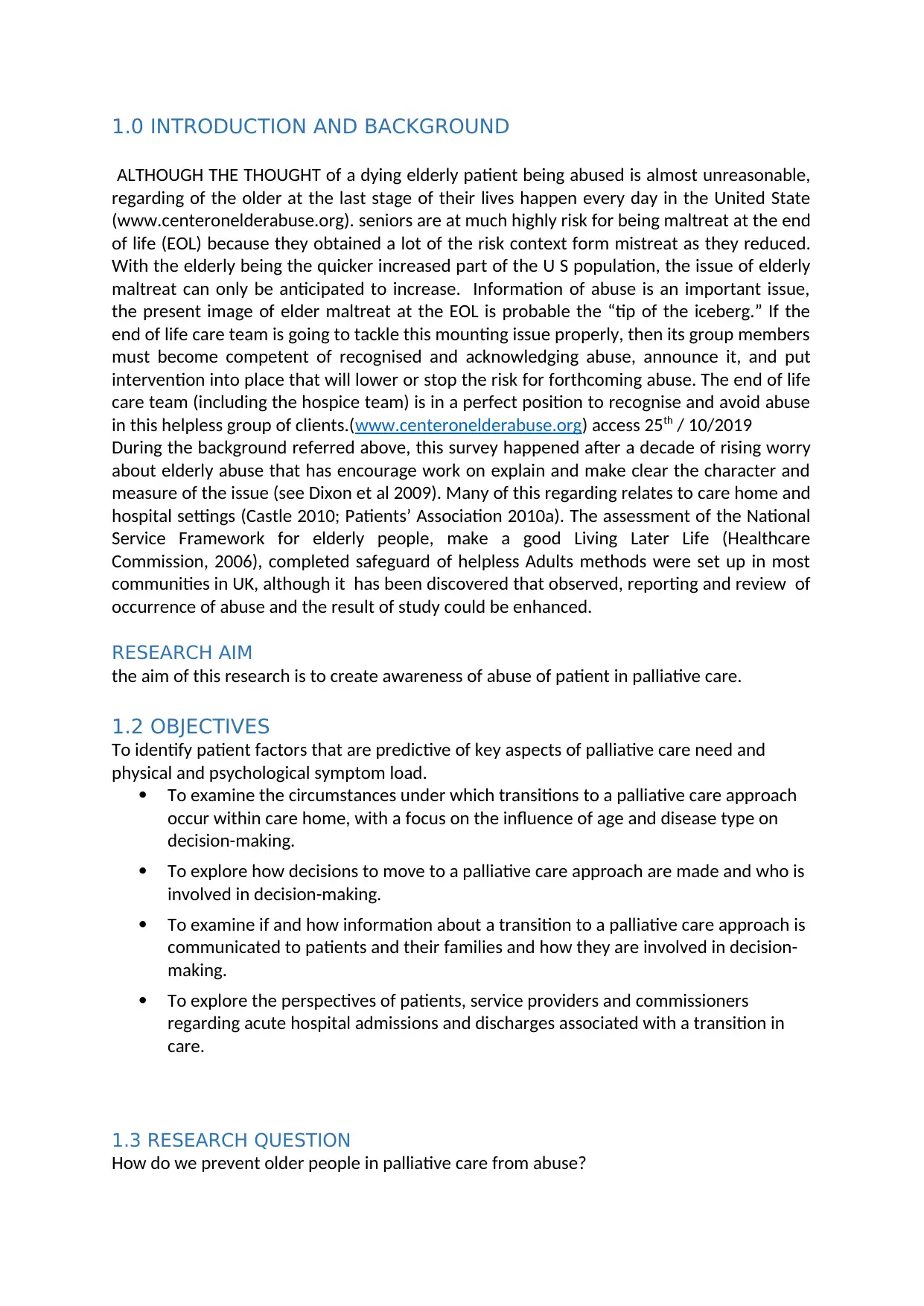
1.0 INTRODUCTION AND BACKGROUND
ALTHOUGH THE THOUGHT of a dying elderly patient being abused is almost unreasonable,
regarding of the older at the last stage of their lives happen every day in the United State
(www.centeronelderabuse.org). seniors are at much highly risk for being maltreat at the end
of life (EOL) because they obtained a lot of the risk context form mistreat as they reduced.
With the elderly being the quicker increased part of the U S population, the issue of elderly
maltreat can only be anticipated to increase. Information of abuse is an important issue,
the present image of elder maltreat at the EOL is probable the “tip of the iceberg.” If the
end of life care team is going to tackle this mounting issue properly, then its group members
must become competent of recognised and acknowledging abuse, announce it, and put
intervention into place that will lower or stop the risk for forthcoming abuse. The end of life
care team (including the hospice team) is in a perfect position to recognise and avoid abuse
in this helpless group of clients.(www.centeronelderabuse.org) access 25th / 10/2019
During the background referred above, this survey happened after a decade of rising worry
about elderly abuse that has encourage work on explain and make clear the character and
measure of the issue (see Dixon et al 2009). Many of this regarding relates to care home and
hospital settings (Castle 2010; Patients’ Association 2010a). The assessment of the National
Service Framework for elderly people, make a good Living Later Life (Healthcare
Commission, 2006), completed safeguard of helpless Adults methods were set up in most
communities in UK, although it has been discovered that observed, reporting and review of
occurrence of abuse and the result of study could be enhanced.
RESEARCH AIM
the aim of this research is to create awareness of abuse of patient in palliative care.
1.2 OBJECTIVES
To identify patient factors that are predictive of key aspects of palliative care need and
physical and psychological symptom load.
To examine the circumstances under which transitions to a palliative care approach
occur within care home, with a focus on the influence of age and disease type on
decision-making.
To explore how decisions to move to a palliative care approach are made and who is
involved in decision-making.
To examine if and how information about a transition to a palliative care approach is
communicated to patients and their families and how they are involved in decision-
making.
To explore the perspectives of patients, service providers and commissioners
regarding acute hospital admissions and discharges associated with a transition in
care.
1.3 RESEARCH QUESTION
How do we prevent older people in palliative care from abuse?
ALTHOUGH THE THOUGHT of a dying elderly patient being abused is almost unreasonable,
regarding of the older at the last stage of their lives happen every day in the United State
(www.centeronelderabuse.org). seniors are at much highly risk for being maltreat at the end
of life (EOL) because they obtained a lot of the risk context form mistreat as they reduced.
With the elderly being the quicker increased part of the U S population, the issue of elderly
maltreat can only be anticipated to increase. Information of abuse is an important issue,
the present image of elder maltreat at the EOL is probable the “tip of the iceberg.” If the
end of life care team is going to tackle this mounting issue properly, then its group members
must become competent of recognised and acknowledging abuse, announce it, and put
intervention into place that will lower or stop the risk for forthcoming abuse. The end of life
care team (including the hospice team) is in a perfect position to recognise and avoid abuse
in this helpless group of clients.(www.centeronelderabuse.org) access 25th / 10/2019
During the background referred above, this survey happened after a decade of rising worry
about elderly abuse that has encourage work on explain and make clear the character and
measure of the issue (see Dixon et al 2009). Many of this regarding relates to care home and
hospital settings (Castle 2010; Patients’ Association 2010a). The assessment of the National
Service Framework for elderly people, make a good Living Later Life (Healthcare
Commission, 2006), completed safeguard of helpless Adults methods were set up in most
communities in UK, although it has been discovered that observed, reporting and review of
occurrence of abuse and the result of study could be enhanced.
RESEARCH AIM
the aim of this research is to create awareness of abuse of patient in palliative care.
1.2 OBJECTIVES
To identify patient factors that are predictive of key aspects of palliative care need and
physical and psychological symptom load.
To examine the circumstances under which transitions to a palliative care approach
occur within care home, with a focus on the influence of age and disease type on
decision-making.
To explore how decisions to move to a palliative care approach are made and who is
involved in decision-making.
To examine if and how information about a transition to a palliative care approach is
communicated to patients and their families and how they are involved in decision-
making.
To explore the perspectives of patients, service providers and commissioners
regarding acute hospital admissions and discharges associated with a transition in
care.
1.3 RESEARCH QUESTION
How do we prevent older people in palliative care from abuse?

⊘ This is a preview!⊘
Do you want full access?
Subscribe today to unlock all pages.

Trusted by 1+ million students worldwide
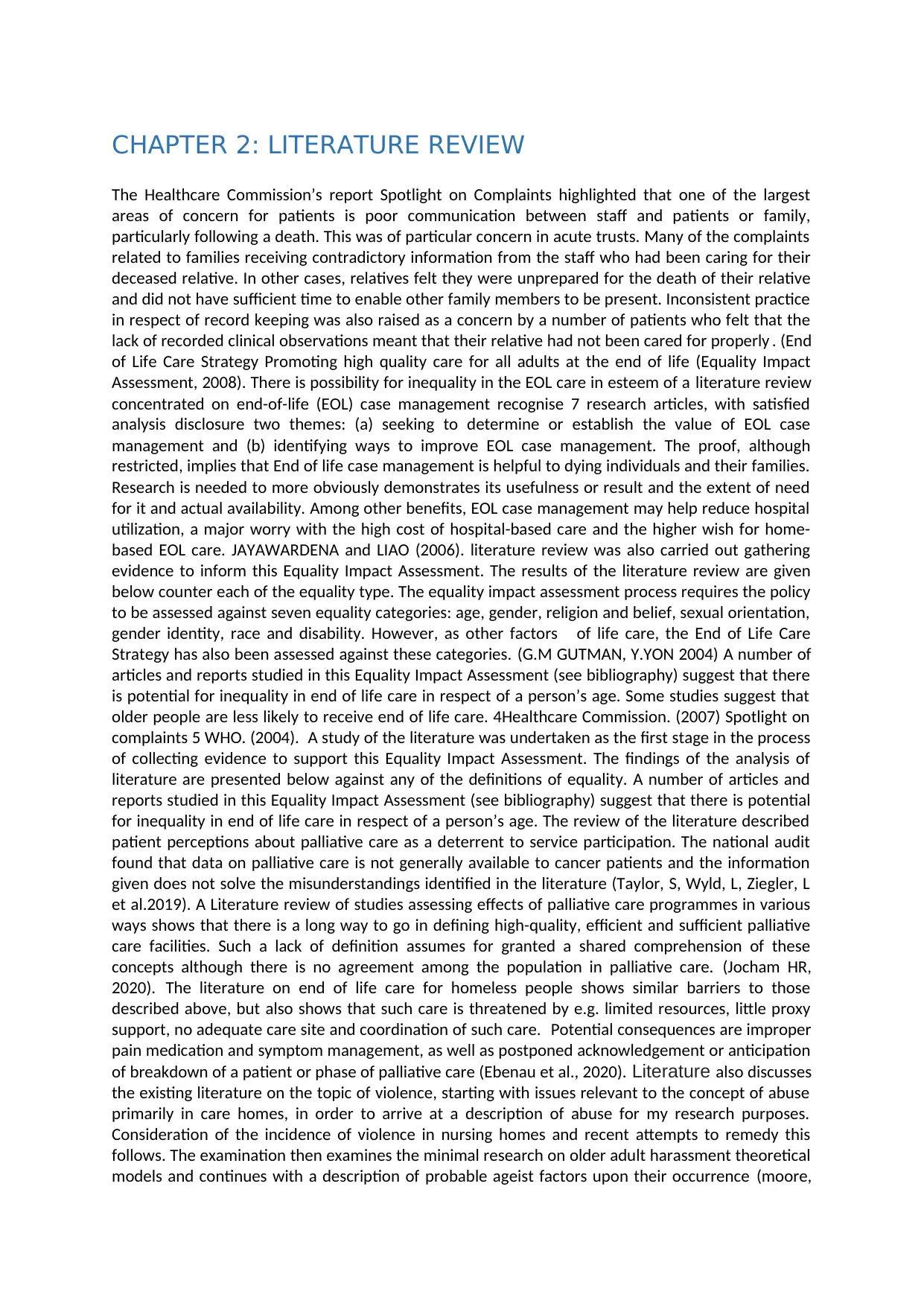
CHAPTER 2: LITERATURE REVIEW
The Healthcare Commission’s report Spotlight on Complaints highlighted that one of the largest
areas of concern for patients is poor communication between staff and patients or family,
particularly following a death. This was of particular concern in acute trusts. Many of the complaints
related to families receiving contradictory information from the staff who had been caring for their
deceased relative. In other cases, relatives felt they were unprepared for the death of their relative
and did not have sufficient time to enable other family members to be present. Inconsistent practice
in respect of record keeping was also raised as a concern by a number of patients who felt that the
lack of recorded clinical observations meant that their relative had not been cared for properly . (End
of Life Care Strategy Promoting high quality care for all adults at the end of life (Equality Impact
Assessment, 2008). There is possibility for inequality in the EOL care in esteem of a literature review
concentrated on end-of-life (EOL) case management recognise 7 research articles, with satisfied
analysis disclosure two themes: (a) seeking to determine or establish the value of EOL case
management and (b) identifying ways to improve EOL case management. The proof, although
restricted, implies that End of life case management is helpful to dying individuals and their families.
Research is needed to more obviously demonstrates its usefulness or result and the extent of need
for it and actual availability. Among other benefits, EOL case management may help reduce hospital
utilization, a major worry with the high cost of hospital-based care and the higher wish for home-
based EOL care. JAYAWARDENA and LIAO (2006). literature review was also carried out gathering
evidence to inform this Equality Impact Assessment. The results of the literature review are given
below counter each of the equality type. The equality impact assessment process requires the policy
to be assessed against seven equality categories: age, gender, religion and belief, sexual orientation,
gender identity, race and disability. However, as other factors of life care, the End of Life Care
Strategy has also been assessed against these categories. (G.M GUTMAN, Y.YON 2004) A number of
articles and reports studied in this Equality Impact Assessment (see bibliography) suggest that there
is potential for inequality in end of life care in respect of a person’s age. Some studies suggest that
older people are less likely to receive end of life care. 4Healthcare Commission. (2007) Spotlight on
complaints 5 WHO. (2004). A study of the literature was undertaken as the first stage in the process
of collecting evidence to support this Equality Impact Assessment. The findings of the analysis of
literature are presented below against any of the definitions of equality. A number of articles and
reports studied in this Equality Impact Assessment (see bibliography) suggest that there is potential
for inequality in end of life care in respect of a person’s age. The review of the literature described
patient perceptions about palliative care as a deterrent to service participation. The national audit
found that data on palliative care is not generally available to cancer patients and the information
given does not solve the misunderstandings identified in the literature (Taylor, S, Wyld, L, Ziegler, L
et al.2019). A Literature review of studies assessing effects of palliative care programmes in various
ways shows that there is a long way to go in defining high-quality, efficient and sufficient palliative
care facilities. Such a lack of definition assumes for granted a shared comprehension of these
concepts although there is no agreement among the population in palliative care. (Jocham HR,
2020). The literature on end of life care for homeless people shows similar barriers to those
described above, but also shows that such care is threatened by e.g. limited resources, little proxy
support, no adequate care site and coordination of such care. Potential consequences are improper
pain medication and symptom management, as well as postponed acknowledgement or anticipation
of breakdown of a patient or phase of palliative care (Ebenau et al., 2020). Literature also discusses
the existing literature on the topic of violence, starting with issues relevant to the concept of abuse
primarily in care homes, in order to arrive at a description of abuse for my research purposes.
Consideration of the incidence of violence in nursing homes and recent attempts to remedy this
follows. The examination then examines the minimal research on older adult harassment theoretical
models and continues with a description of probable ageist factors upon their occurrence (moore,
The Healthcare Commission’s report Spotlight on Complaints highlighted that one of the largest
areas of concern for patients is poor communication between staff and patients or family,
particularly following a death. This was of particular concern in acute trusts. Many of the complaints
related to families receiving contradictory information from the staff who had been caring for their
deceased relative. In other cases, relatives felt they were unprepared for the death of their relative
and did not have sufficient time to enable other family members to be present. Inconsistent practice
in respect of record keeping was also raised as a concern by a number of patients who felt that the
lack of recorded clinical observations meant that their relative had not been cared for properly . (End
of Life Care Strategy Promoting high quality care for all adults at the end of life (Equality Impact
Assessment, 2008). There is possibility for inequality in the EOL care in esteem of a literature review
concentrated on end-of-life (EOL) case management recognise 7 research articles, with satisfied
analysis disclosure two themes: (a) seeking to determine or establish the value of EOL case
management and (b) identifying ways to improve EOL case management. The proof, although
restricted, implies that End of life case management is helpful to dying individuals and their families.
Research is needed to more obviously demonstrates its usefulness or result and the extent of need
for it and actual availability. Among other benefits, EOL case management may help reduce hospital
utilization, a major worry with the high cost of hospital-based care and the higher wish for home-
based EOL care. JAYAWARDENA and LIAO (2006). literature review was also carried out gathering
evidence to inform this Equality Impact Assessment. The results of the literature review are given
below counter each of the equality type. The equality impact assessment process requires the policy
to be assessed against seven equality categories: age, gender, religion and belief, sexual orientation,
gender identity, race and disability. However, as other factors of life care, the End of Life Care
Strategy has also been assessed against these categories. (G.M GUTMAN, Y.YON 2004) A number of
articles and reports studied in this Equality Impact Assessment (see bibliography) suggest that there
is potential for inequality in end of life care in respect of a person’s age. Some studies suggest that
older people are less likely to receive end of life care. 4Healthcare Commission. (2007) Spotlight on
complaints 5 WHO. (2004). A study of the literature was undertaken as the first stage in the process
of collecting evidence to support this Equality Impact Assessment. The findings of the analysis of
literature are presented below against any of the definitions of equality. A number of articles and
reports studied in this Equality Impact Assessment (see bibliography) suggest that there is potential
for inequality in end of life care in respect of a person’s age. The review of the literature described
patient perceptions about palliative care as a deterrent to service participation. The national audit
found that data on palliative care is not generally available to cancer patients and the information
given does not solve the misunderstandings identified in the literature (Taylor, S, Wyld, L, Ziegler, L
et al.2019). A Literature review of studies assessing effects of palliative care programmes in various
ways shows that there is a long way to go in defining high-quality, efficient and sufficient palliative
care facilities. Such a lack of definition assumes for granted a shared comprehension of these
concepts although there is no agreement among the population in palliative care. (Jocham HR,
2020). The literature on end of life care for homeless people shows similar barriers to those
described above, but also shows that such care is threatened by e.g. limited resources, little proxy
support, no adequate care site and coordination of such care. Potential consequences are improper
pain medication and symptom management, as well as postponed acknowledgement or anticipation
of breakdown of a patient or phase of palliative care (Ebenau et al., 2020). Literature also discusses
the existing literature on the topic of violence, starting with issues relevant to the concept of abuse
primarily in care homes, in order to arrive at a description of abuse for my research purposes.
Consideration of the incidence of violence in nursing homes and recent attempts to remedy this
follows. The examination then examines the minimal research on older adult harassment theoretical
models and continues with a description of probable ageist factors upon their occurrence (moore,
Paraphrase This Document
Need a fresh take? Get an instant paraphrase of this document with our AI Paraphraser
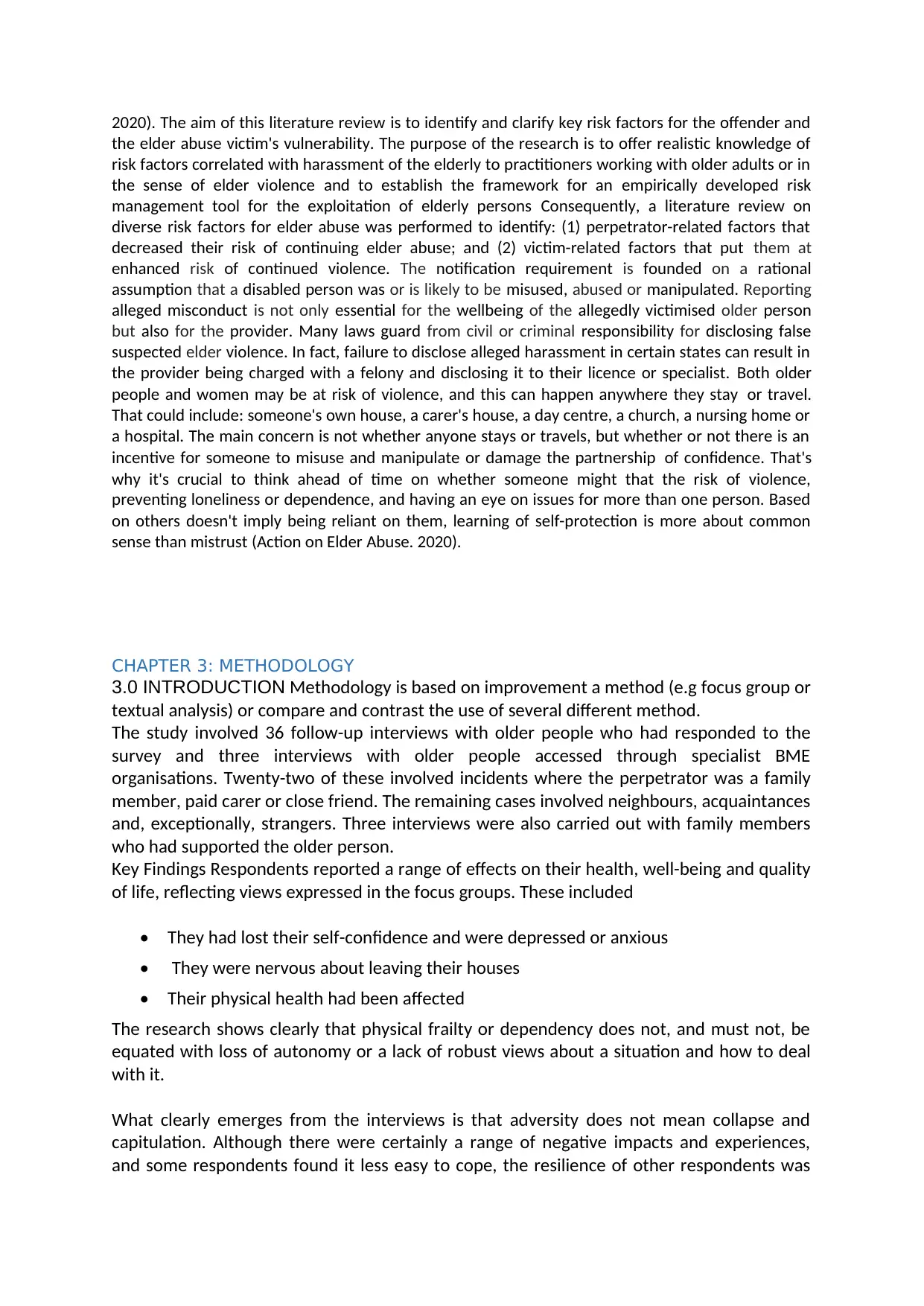
2020). The aim of this literature review is to identify and clarify key risk factors for the offender and
the elder abuse victim's vulnerability. The purpose of the research is to offer realistic knowledge of
risk factors correlated with harassment of the elderly to practitioners working with older adults or in
the sense of elder violence and to establish the framework for an empirically developed risk
management tool for the exploitation of elderly persons Consequently, a literature review on
diverse risk factors for elder abuse was performed to identify: (1) perpetrator-related factors that
decreased their risk of continuing elder abuse; and (2) victim-related factors that put them at
enhanced risk of continued violence. The notification requirement is founded on a rational
assumption that a disabled person was or is likely to be misused, abused or manipulated. Reporting
alleged misconduct is not only essential for the wellbeing of the allegedly victimised older person
but also for the provider. Many laws guard from civil or criminal responsibility for disclosing false
suspected elder violence. In fact, failure to disclose alleged harassment in certain states can result in
the provider being charged with a felony and disclosing it to their licence or specialist. Both older
people and women may be at risk of violence, and this can happen anywhere they stay or travel.
That could include: someone's own house, a carer's house, a day centre, a church, a nursing home or
a hospital. The main concern is not whether anyone stays or travels, but whether or not there is an
incentive for someone to misuse and manipulate or damage the partnership of confidence. That's
why it's crucial to think ahead of time on whether someone might that the risk of violence,
preventing loneliness or dependence, and having an eye on issues for more than one person. Based
on others doesn't imply being reliant on them, learning of self-protection is more about common
sense than mistrust (Action on Elder Abuse. 2020).
CHAPTER 3: METHODOLOGY
3.0 INTRODUCTION Methodology is based on improvement a method (e.g focus group or
textual analysis) or compare and contrast the use of several different method.
The study involved 36 follow-up interviews with older people who had responded to the
survey and three interviews with older people accessed through specialist BME
organisations. Twenty-two of these involved incidents where the perpetrator was a family
member, paid carer or close friend. The remaining cases involved neighbours, acquaintances
and, exceptionally, strangers. Three interviews were also carried out with family members
who had supported the older person.
Key Findings Respondents reported a range of effects on their health, well-being and quality
of life, reflecting views expressed in the focus groups. These included
• They had lost their self-confidence and were depressed or anxious
• They were nervous about leaving their houses
• Their physical health had been affected
The research shows clearly that physical frailty or dependency does not, and must not, be
equated with loss of autonomy or a lack of robust views about a situation and how to deal
with it.
What clearly emerges from the interviews is that adversity does not mean collapse and
capitulation. Although there were certainly a range of negative impacts and experiences,
and some respondents found it less easy to cope, the resilience of other respondents was
the elder abuse victim's vulnerability. The purpose of the research is to offer realistic knowledge of
risk factors correlated with harassment of the elderly to practitioners working with older adults or in
the sense of elder violence and to establish the framework for an empirically developed risk
management tool for the exploitation of elderly persons Consequently, a literature review on
diverse risk factors for elder abuse was performed to identify: (1) perpetrator-related factors that
decreased their risk of continuing elder abuse; and (2) victim-related factors that put them at
enhanced risk of continued violence. The notification requirement is founded on a rational
assumption that a disabled person was or is likely to be misused, abused or manipulated. Reporting
alleged misconduct is not only essential for the wellbeing of the allegedly victimised older person
but also for the provider. Many laws guard from civil or criminal responsibility for disclosing false
suspected elder violence. In fact, failure to disclose alleged harassment in certain states can result in
the provider being charged with a felony and disclosing it to their licence or specialist. Both older
people and women may be at risk of violence, and this can happen anywhere they stay or travel.
That could include: someone's own house, a carer's house, a day centre, a church, a nursing home or
a hospital. The main concern is not whether anyone stays or travels, but whether or not there is an
incentive for someone to misuse and manipulate or damage the partnership of confidence. That's
why it's crucial to think ahead of time on whether someone might that the risk of violence,
preventing loneliness or dependence, and having an eye on issues for more than one person. Based
on others doesn't imply being reliant on them, learning of self-protection is more about common
sense than mistrust (Action on Elder Abuse. 2020).
CHAPTER 3: METHODOLOGY
3.0 INTRODUCTION Methodology is based on improvement a method (e.g focus group or
textual analysis) or compare and contrast the use of several different method.
The study involved 36 follow-up interviews with older people who had responded to the
survey and three interviews with older people accessed through specialist BME
organisations. Twenty-two of these involved incidents where the perpetrator was a family
member, paid carer or close friend. The remaining cases involved neighbours, acquaintances
and, exceptionally, strangers. Three interviews were also carried out with family members
who had supported the older person.
Key Findings Respondents reported a range of effects on their health, well-being and quality
of life, reflecting views expressed in the focus groups. These included
• They had lost their self-confidence and were depressed or anxious
• They were nervous about leaving their houses
• Their physical health had been affected
The research shows clearly that physical frailty or dependency does not, and must not, be
equated with loss of autonomy or a lack of robust views about a situation and how to deal
with it.
What clearly emerges from the interviews is that adversity does not mean collapse and
capitulation. Although there were certainly a range of negative impacts and experiences,
and some respondents found it less easy to cope, the resilience of other respondents was
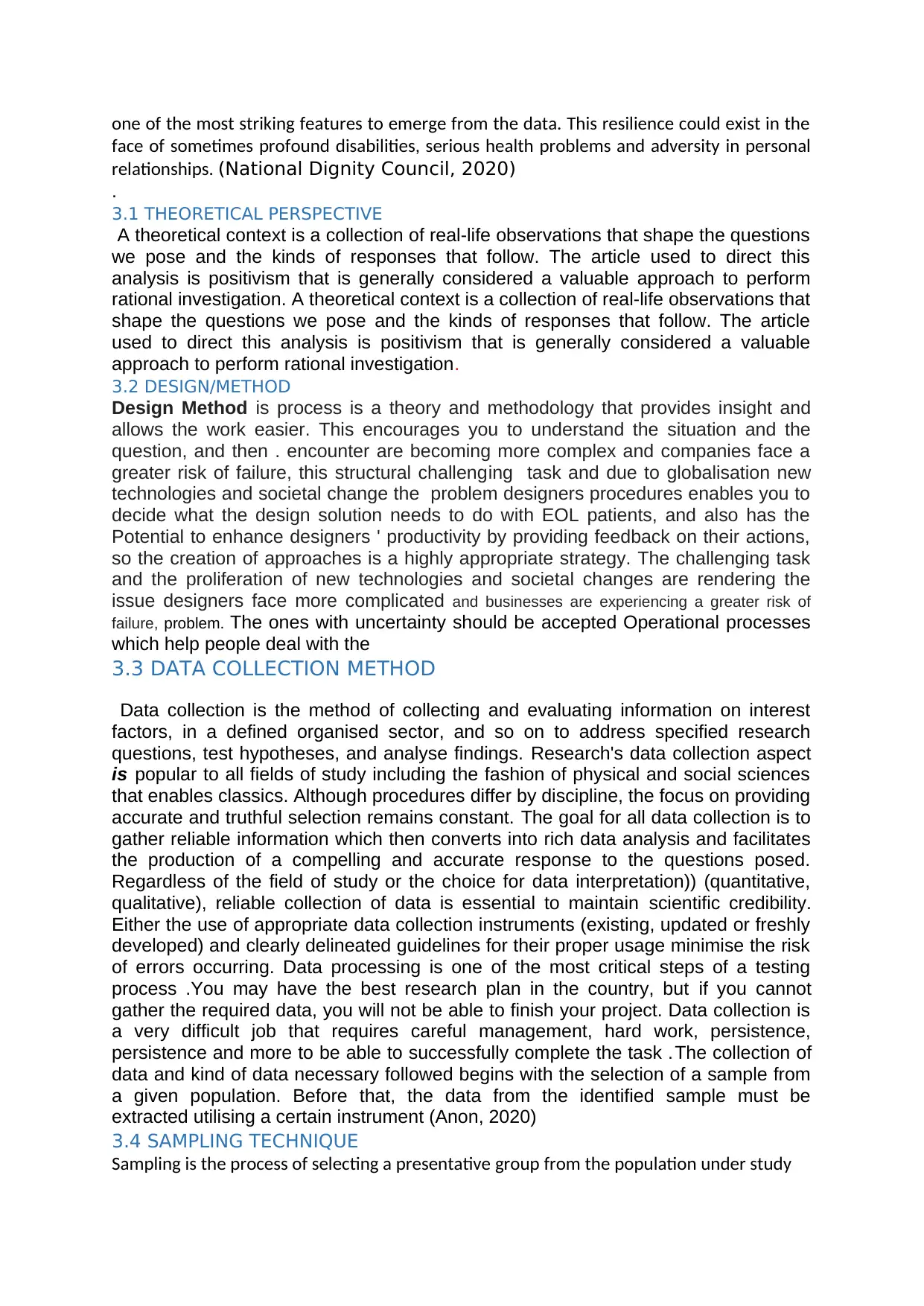
one of the most striking features to emerge from the data. This resilience could exist in the
face of sometimes profound disabilities, serious health problems and adversity in personal
relationships. (National Dignity Council, 2020)
.
3.1 THEORETICAL PERSPECTIVE
A theoretical context is a collection of real-life observations that shape the questions
we pose and the kinds of responses that follow. The article used to direct this
analysis is positivism that is generally considered a valuable approach to perform
rational investigation. A theoretical context is a collection of real-life observations that
shape the questions we pose and the kinds of responses that follow. The article
used to direct this analysis is positivism that is generally considered a valuable
approach to perform rational investigation.
3.2 DESIGN/METHOD
Design Method is process is a theory and methodology that provides insight and
allows the work easier. This encourages you to understand the situation and the
question, and then . encounter are becoming more complex and companies face a
greater risk of failure, this structural challenging task and due to globalisation new
technologies and societal change the problem designers procedures enables you to
decide what the design solution needs to do with EOL patients, and also has the
Potential to enhance designers ' productivity by providing feedback on their actions,
so the creation of approaches is a highly appropriate strategy. The challenging task
and the proliferation of new technologies and societal changes are rendering the
issue designers face more complicated and businesses are experiencing a greater risk of
failure, problem. The ones with uncertainty should be accepted Operational processes
which help people deal with the
3.3 DATA COLLECTION METHOD
Data collection is the method of collecting and evaluating information on interest
factors, in a defined organised sector, and so on to address specified research
questions, test hypotheses, and analyse findings. Research's data collection aspect
is popular to all fields of study including the fashion of physical and social sciences
that enables classics. Although procedures differ by discipline, the focus on providing
accurate and truthful selection remains constant. The goal for all data collection is to
gather reliable information which then converts into rich data analysis and facilitates
the production of a compelling and accurate response to the questions posed.
Regardless of the field of study or the choice for data interpretation)) (quantitative,
qualitative), reliable collection of data is essential to maintain scientific credibility.
Either the use of appropriate data collection instruments (existing, updated or freshly
developed) and clearly delineated guidelines for their proper usage minimise the risk
of errors occurring. Data processing is one of the most critical steps of a testing
process .You may have the best research plan in the country, but if you cannot
gather the required data, you will not be able to finish your project. Data collection is
a very difficult job that requires careful management, hard work, persistence,
persistence and more to be able to successfully complete the task .The collection of
data and kind of data necessary followed begins with the selection of a sample from
a given population. Before that, the data from the identified sample must be
extracted utilising a certain instrument (Anon, 2020)
3.4 SAMPLING TECHNIQUE
Sampling is the process of selecting a presentative group from the population under study
face of sometimes profound disabilities, serious health problems and adversity in personal
relationships. (National Dignity Council, 2020)
.
3.1 THEORETICAL PERSPECTIVE
A theoretical context is a collection of real-life observations that shape the questions
we pose and the kinds of responses that follow. The article used to direct this
analysis is positivism that is generally considered a valuable approach to perform
rational investigation. A theoretical context is a collection of real-life observations that
shape the questions we pose and the kinds of responses that follow. The article
used to direct this analysis is positivism that is generally considered a valuable
approach to perform rational investigation.
3.2 DESIGN/METHOD
Design Method is process is a theory and methodology that provides insight and
allows the work easier. This encourages you to understand the situation and the
question, and then . encounter are becoming more complex and companies face a
greater risk of failure, this structural challenging task and due to globalisation new
technologies and societal change the problem designers procedures enables you to
decide what the design solution needs to do with EOL patients, and also has the
Potential to enhance designers ' productivity by providing feedback on their actions,
so the creation of approaches is a highly appropriate strategy. The challenging task
and the proliferation of new technologies and societal changes are rendering the
issue designers face more complicated and businesses are experiencing a greater risk of
failure, problem. The ones with uncertainty should be accepted Operational processes
which help people deal with the
3.3 DATA COLLECTION METHOD
Data collection is the method of collecting and evaluating information on interest
factors, in a defined organised sector, and so on to address specified research
questions, test hypotheses, and analyse findings. Research's data collection aspect
is popular to all fields of study including the fashion of physical and social sciences
that enables classics. Although procedures differ by discipline, the focus on providing
accurate and truthful selection remains constant. The goal for all data collection is to
gather reliable information which then converts into rich data analysis and facilitates
the production of a compelling and accurate response to the questions posed.
Regardless of the field of study or the choice for data interpretation)) (quantitative,
qualitative), reliable collection of data is essential to maintain scientific credibility.
Either the use of appropriate data collection instruments (existing, updated or freshly
developed) and clearly delineated guidelines for their proper usage minimise the risk
of errors occurring. Data processing is one of the most critical steps of a testing
process .You may have the best research plan in the country, but if you cannot
gather the required data, you will not be able to finish your project. Data collection is
a very difficult job that requires careful management, hard work, persistence,
persistence and more to be able to successfully complete the task .The collection of
data and kind of data necessary followed begins with the selection of a sample from
a given population. Before that, the data from the identified sample must be
extracted utilising a certain instrument (Anon, 2020)
3.4 SAMPLING TECHNIQUE
Sampling is the process of selecting a presentative group from the population under study
⊘ This is a preview!⊘
Do you want full access?
Subscribe today to unlock all pages.

Trusted by 1+ million students worldwide
1 out of 34
Related Documents
Your All-in-One AI-Powered Toolkit for Academic Success.
+13062052269
info@desklib.com
Available 24*7 on WhatsApp / Email
![[object Object]](/_next/static/media/star-bottom.7253800d.svg)
Unlock your academic potential
Copyright © 2020–2025 A2Z Services. All Rights Reserved. Developed and managed by ZUCOL.





